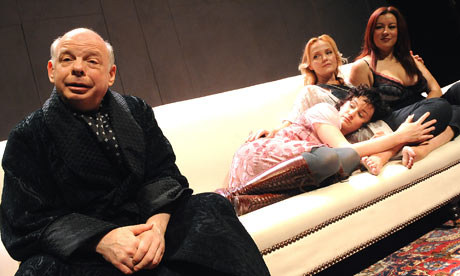
A quiet and typical family scene opens: preparations are being made for a family dinner in a liberal suburban town in New York state.
Newcomer Tim is introduced to a family of four adult siblings and their memory-challenged uncle Ben.
Written and directed by Richard Nelson, there's just enough-of-everything present in the room to create an evening of surprise, drama, humor, and sharp daggers of politicized anger and - even - irrational hatred. Underscoring the dialogue is the premise that one of the siblings, Jane, is researching a book that she imagines might be useful as a societal autobiography: the manner and mores of common social situations revealing deeper beliefs and values by both "what is said" and "what is not said."
The playwright has cleverly focused the audience's attention on the unspoken.
A brilliant piece of writing and beautifully acted. -dp
From Joe Dziemianowicz's review in the New York Post:
http://www.nydailynews.com/entertainment/music-arts/hopey-changey-wake-reviews-fine-tuned-ensembes-drive-political-plays-article-1.450088Fine-tuned ensembles drive two politically charged plays at the Public Theater.
Richard Nelson's "That Hopey Changey Thing" begins with a dying cry of a dog, Oliver. The whimper echoes the sick feelings of everyone at the cozy Rhinebeck home of high-school English teacher Barbara Apple (Maryann Plunkett).
She lives there with her ailing uncle Benjamin (Jon DeVries), a retired actor with amnesia brought on by a heart attack. Also on hand are Barbara's siblings -- Richard (Jay O. Sanders), a state lawyer, Marian (Laila Robins), a second-grade teacher, and Jane (J. Smith-Cameron), a writer who's brought her actor boyfriend Tim (Shuler Hensley).
It's Election Night 2010 (as in Tuesday) and this liberal Democratic clan expects a beating at the polls. Talk turns to "us" and "them," Cuomo, who's a shoo-in, and disenchantment with Obama. The mention of Sarah Palin (whose quote inspires the title) causes choking. Ditto when Richard reveals he has taken a job with the Republicans.
For timeliness, "Hopey Changey," presented as part of the Public's issue-oriented Lab series, has immediacy. But the election-night setting is just a convenience. What makes the play interesting is the detailed portrait that emerges of the all-American Apples -- a group with polish, bruises and maybe a even worm or two.
Nelson, who directs his play, evokes the Apples in conversation that sounds as natural as breathing. And the cast couldn't be better.
There's also a never-seen character, Toby, a new pooch for Benjamin to replace Oliver, who kept soiling the house in his dying days. Toby makes the same messes his predecessor did. In that way, he's like a lot of elected officials.
Read more: http://www.nydailynews.com/entertainment/music-arts/hopey-changey-wake-reviews-fine-tuned-ensembes-drive-political-plays-article-1.450088#ixzz2j1mF2I3E


.JPG)
.JPG)